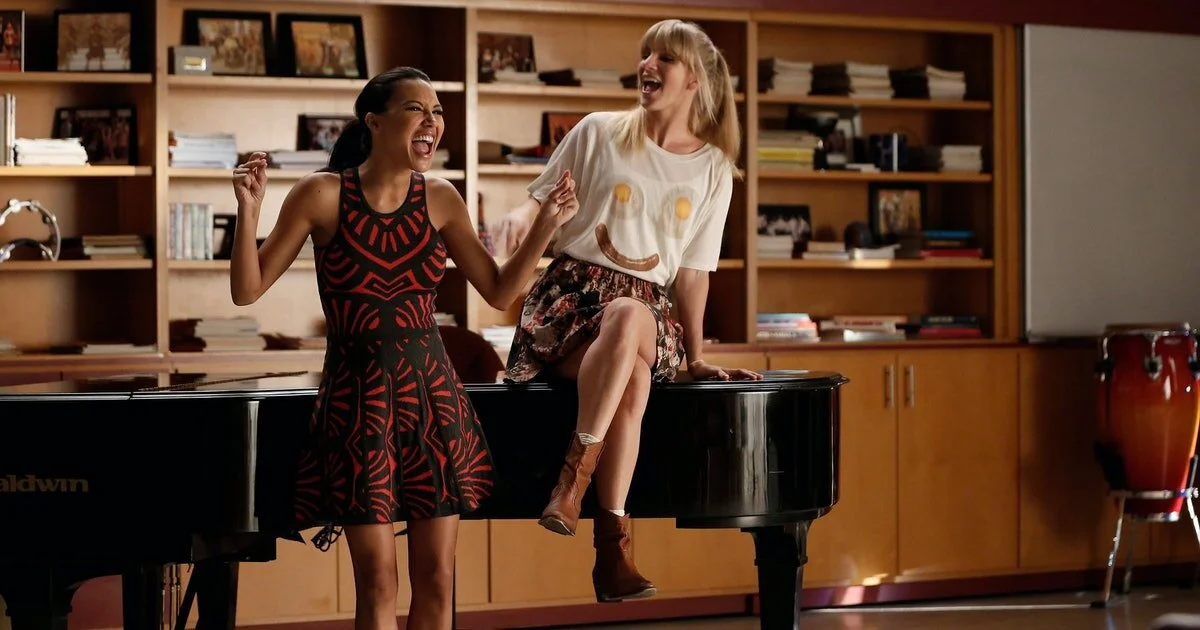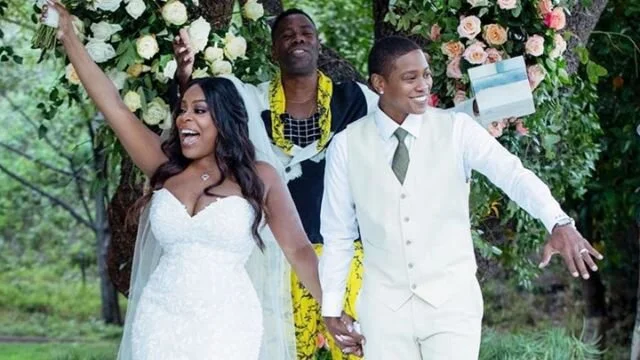Remembering Naya Rivera As A Trailblazer of LGBTQ TV
Nearly a week after actress Naya Rivera’s heartbreaking disappearance while boating with her son on Lake Piru in California, authorities have released information that Rivera’s body has been found. Recent reports have answered questions of how the incident occurred by adding that Naya and her son were swimming in the lake when the boat drifted too far away from them. In an attempt to get back on board, Rivera risked her life by rescuing her son, but succumbed to a loss of energy and drowned.
News of Rivera’s sudden death has caused shockwaves of heartache throughout the world as friends, family, and fans grieve her tragic loss. Her death is a tragedy for so many, including those in the LGBTQ community who were so empowered by the representation of her lesbian character, Santana Lopez, on Glee.
Heather Morris (Brittany) and Naya Rivera (Santana) on Glee - Fox/Photofest
Although Santana was originally written as a background character, occasionally popping in to shake her pom-poms and deliver some of the most priceless one-liners to grace our televisions, the talent and nuance of Naya Rivera propelled her character into a brighter spotlight. As a result, Santana quickly emerged with passion and ferocity into the show’s main cast. She became the prime reason for watching Glee, livening up each episode with her trademark charm and hilarity.
As a teenager at the time Glee first aired, Naya Rivera’s portrayal of lesbian triumphs, love, and pain nestled directly into my soul. Her character, the quick-witted, bombshell cheerleader, changed not only the way I saw myself represented, but the history of queer television for a generation of millennial viewers. She was the first character on primetime TV who truly made me feel represented as a femme latina lesbian—and it was a total cherry on top that, like me, she had a sharp tongue with a soft heart underneath.
Watching Santana on Glee, ritually surrounded by my parents after dinner on Tuesday nights, was vastly different than sneaking Blockbuster DVD’s of The L Word up the stairs and into my bedroom in 2004. Her character normalized the teen lesbian experience for millions of families, and it wasn’t just because she was a lesbian on TV—Santana’s storyline, from season one in 2009 all the way through season six in 2015, encapsulated the high-school queer experience.
Naya Rivera (Santana) and Heather Morris (Brittany) on Glee - Fox/Photofest
What started with a throwaway line between Santana and her best friend Brittany in season one became a full-fledged romance that lasted throughout the series. As a couple, they celebrated the triumphs of a first kiss, confessed their feelings for one another, and experienced the joys of falling in love with a best friend. They grappled with the hardships of coming out, acceptance among family and friends, heartbreak, and the lesbian classic: long distance relationships. Their story wasn’t just relegated to a few special episodes—it was given as much development as their counterparts and passionately evolved with their characters throughout the series.
The relationship between Santana and Brittany on Glee showed touchstone moments of representation for viewers like me. When Santana, confused by her crush on Brittany, processed her emotions by singing and dancing her heart out, she gave visibility to many young and questioning LGBTQ teens. When she felt the pains of denial and fear of non-acceptance by her family and friends, her story resonated with the hardships faced by our community. Above all, her ability to overcome her shame, to learn to embrace her sexuality, and to practice the radical act of self-love sent a hopeful and inspiring message to queer youth.
As a lesbian viewer, and like so many others in the community, I could see parts of myself in Santana’s story. When she beautifully serenaded her secret crush to Landslide, I thought back to the many SoundCloud tracks I had stayed up all night recording to send to my high-school girlfriend. When she confessed her love for Brittany, I felt that telltale confusion, freedom and excitement. When Santana came out to her grandmother, I passionately empathized and remembered my own fears coming out to my Mexican family. Glee came on air before marriage equality was even legalized in the United States, so when Santana and Brittany escaped to Indiana to get married, my dreams of marrying my girlfriend burned all the brighter. As writer Jill Gutowitz perfectly stated, Naya also taught me that “Santana could be vulnerable without giving up any of her power.”
Heather Morris (Brittany) and Naya Rivera (Santana) - Fox Network/Photofest
Glee’s romantic partnership between two cheerleading best friends challenged stereotypes set forth by predecessor TV shows, which have historically portrayed women in same-sex relationships through the lens of heteronormative gender roles. As a femme-femme couple, Brittany and Santana helped me to understand that there’s a place for me within the LGBTQ community and a place for sharing my story on television. While their relationship notably paved the way for this new type of lesbian love story, the ultimate victory in witnessing their journey came in season six when their storyline ended happily with a marriage—something that is still wildly uncommon for television shows or movies depicting queer characters today.
Not only did Naya Rivera bring visibility to the LGBTQ folks through her portrayal of Santana on Glee, but she went beyond her place on the small screen to advocate for the community. She attended and hosted the GLAAD Media Awards, participated in the No H8 Campaign to promote marriage and gender equality, and raised awareness of LGBTQ discrimination and bullying. In 2018, Rivera wrote a love letter to the LGBTQ community for Billboard. In her letter, Rivera stated:
“I have been so incredibly fortunate to portray a character on television that has meant so much to so many within the LGBTQ community. Off screen, I am a woman who stands in support of equality, and equal rights for all. It has been one of the great blessings in my life to receive such love and touching stories as a result of my portrayal of Santana Lopez on Glee. We are all put on this earth to be a service to others and I am grateful that for some, my Cheerios ponytail and sassy sashays may have given a little light to someone somewhere, who may have needed it. To everyone whose heartfelt stories I have heard, or read I thank you for truly enriching my life.”
Without Naya Rivera championing for the community through Santana’s storyline on Glee, the on-screen relationship between Santana and Brittany that changed the lives of so many wouldn’t have transpired with the depth and heart that we all came to know and love. At a ComicCon interview in 2011, Glee co-creator Brad Falchuck admitted that the Santana and Brittany relationship was first brought onto the show as “a goof.” Later that year, Rivera spoke to E! to share her thoughts on the storyline, adding “it's up to writers, but I would love to represent [the LGBTQ community] because we know that there are tons of people who experience something like that and it's not comical for them in their lives—what they are going through that we are representing. So I hope that maybe we can shed some light on that.”
Rivera embraced her identity as a Latinx woman in Hollywood and wrote about her experiences in her memoir, Sorry Not Sorry. She spoke publicly about her own mental health journey, helping young women all over the world feel supported in their own experiences. In a touching personal Instagram post during during the Black Lives Matter protests, Rivera posted a picture of her grandmother in a newspaper clipping, stating:
Naya Rivera for Vanity Fair
“In times like these and always we must stand up and be counted. Stand up against injustice. Prejudice. Pure evil. These are photos of my grandma protesting for civil rights in the 60s. She was an advocate for civil, women’s, and human rights. She is my hero. This morning I meditated on her, on what we are all seeing play out in front of us today. It has been playing out for decades. We have been fighting this same fight for centuries. I am proud to come from a lineage of people who stand up for what is right. I am proud of every peaceful protestor, every person who is saying NO. I know my grandma Clara is looking down on me, on all of us and encouraging everyone to keep up the GOOD fight. The fight that gets our point across without giving anyone access to taint our mission with a false narrative of who we really are. Justice. Equality. Peace. Respect. My grandma stood up. I stand up.”
Though as a series Glee has had its share of ups and downs in the spotlight, Santana’s journey will always resonate with me. The relationship between Santana and Brittany that evolved for six seasons of the show gave millions of LGBTQ viewers not only a voice, but power, visibility, and validation. Naya Rivera’s legacy will be remembered far beyond her impact of the LGBTQ community on the small screen, but her talent and advocacy helped foster and empower a whole generation of young queer women to embrace who they are, to come out of the closet, and to live courageously with self-acceptance and love.
She is remembered as a loving mother, daughter, author, singer, advocate, and actress in the hearts of us all.










